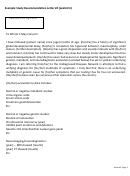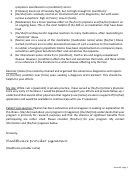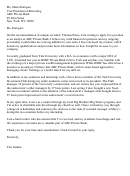Example Study Recommendation Letter #1 (Pediatric)
ADVERTISEMENT
Example Study Recommendation Letter #1 (pediatric)
Hospital/clinic logo here
To Whom it May Concern:
We are writing to you to request consideration of siblings, [patient names], for enrollment in
the Undiagnosed Diseases Network (UDN). [Patient names] are followed by multiple specialists
at [hospital name]. They are also followed by local pediatrician [physician name] for routine
pediatric care.
[Patient name] is now a [age] year old [gender] with a history of dysmorphic features, failure to
thrive, and hepatomegaly of unknown origin. Due to cryptogenic cirrhosis, liver transplant was
performed at [age] months of age. Pathology results of [patient name]’s previous liver biopsy
was suspicious for a [condition], specifically [specific condition], however, molecular testing for
the [gene name] was negative. [Condition] enzyme screening and [condition] screen for the
explanted liver sample came back in the low ranges, but not in the deficiency range usually seen.
Additional extensive workup was unrevealing.
[Patient name] is now a [age] month old [gender] noted prenatally to have holoprosencephaly
via fetal MRI at [time] weeks gestation. Brain MRI performed on DOL [time] was consistent with
[description of MRI]. [He/she] was admitted at [age] months of life for evaluation of liver
steatosis, microcephaly, and failure to thrive. At [age] months of age, [patient name] was
identified to have new onset hepatomegaly in [month] with vomiting. A liver biopsy from [date]
identified [results of liver biopsy]. Due to persistent FTT, G tube was placed in [month] with
subsequent fungal peritonitis, now post-[time] day course of [medication]. [Patient name]
continues to have daily emesis. [Patient name] is currently evaluated for liver transplantation
(persistently elevated transaminases and synthetic dysfunction).
Of note, both siblings have a history of IUGR with failure to thrive, improved for [patient name]
following liver transplantation. [Patient name] has a history of developmental delays, making
significant progress with therapies, and now within normal limits. [Patient name] continues to
have developmental delays and facial features similar to [his/her] [brother/sister] during
infancy. Given the similarities in the presentation of these two siblings with an unremarkable
family history (parents are not consanguineous), whole exome sequencing was obtained for
[patient name] and identified a heterozygous mutation in the [gene name], which in the
homozygous state is associated with [condition]. Subsequent deletion/duplication testing via
the MitoMet oligonucleotide array returned as normal. Mitochondrial genome testing via
Letter #1, Page 1
ADVERTISEMENT
0 votes
Related Articles
Related forms
Related Categories
Parent category: Letters
 1
1 2
2 3
3 4
4 5
5 6
6 7
7 8
8








